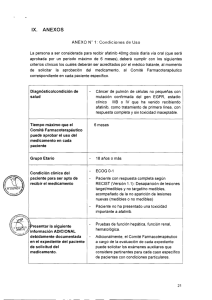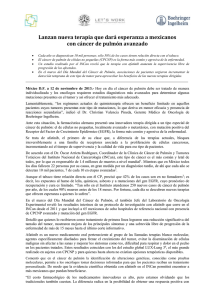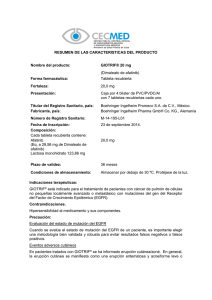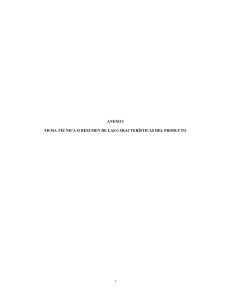TRATAMIENTO INDIVIDUALIZADO CON TKIs EN CÁNCER DE
Anuncio
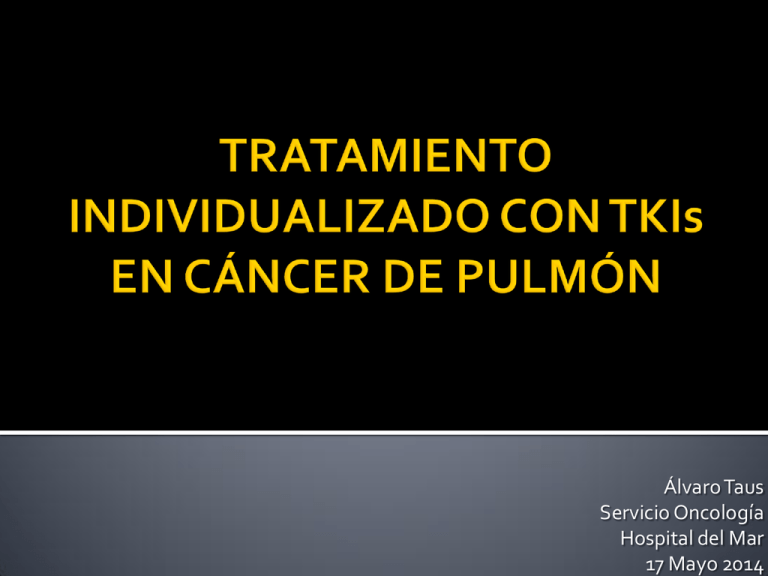
Álvaro Taus Servicio Oncología Hospital del Mar 17 Mayo 2014 Introducción Epidemiología CPCNP Tratamientos dirigidos TERAPIAS ANTI-EGFR Erlotinib Gefitinib Afatinib Caso clínico TERAPIAS ANTI-ALK Crizotinib Caso clínico Conclusiones Siegel. Cancer CA Cancer J Clin 2014 Fármacos contra vías de señalización críticas para el crecimiento tumoral sin comprometer órganos y tejidos normales: Solo funciona contra tumores que contengan la diana. En pacientes seleccionados más eficaces que la QT y menos efectos secundarios. La diana debe poder ser medida y esta medida debe correlacionarse con la eficacia del tratamiento. NCI Diccionary of Cancer Terms. Retrieved 2009-01-25. Sledge. JCO 2005 Lung Cancer Mutation Consortium Cataldo NEJM 2011 Irmer. Oncogene 2007 GEFITINIB Inhibidor reversible EGFR ERLOTINIB Inhibidor reversible EGFR Actividad en EGFR no mutados (Resp.<10%) AFATINIB Inhibidor irreversible EGFR, HER2, ErbB4 Actividad tras fallo de Gefitinib / Erlotinib CPNCP IIIb-IV, 1ª línea Mut. Sensibilidad EGFR** Ausencia T790M exon20 n: 230 *randomización 1:1 **delección exon19, L858R exon21 R A N D O M I Z A C I Ó N * Gefitinib 250mg día Carboplatino/Paclitaxel AUC 5-6/200mg/m² cada 21d PFS Gefitinib 10.8 m QT 5.4 m HR 0.30, p<0.001 OS Gefitinib 30.5 m QT 23.6 m P=0.31 Cross-over: 95% 12 Lancet Oncol 2012 Erlotinib 9.7 m vs 5.2 Qt Afatinib es un inhibidor irreversible oral de la familia ErbB. Inhibicion de la heterodimerización de la familia de receptores ErbB Li D, et al. Oncogene 2008;27:4702–11. Todas las mutaciones Mutaciones clásicas de sensibilidad Afatinib (n=229) n (%) Cis/pem (n=111) n (%) 229 (100.0) 109 (98.2) 228 (99.6) 106 (95.5) 139 (60.7) 63 (56.8) Drug-related AEs ≥3 112 (48.9) 53 (47.7) AE leading to discontinuation 23 (10.0) 16 (14.4) 18 (7.9)*† 13 (11.7) 66 (28.8) 25 (22.5) 33 (14.4) 16 (14.4) 4 (1.7)‡ 0 (0.0) Any AEs Drug-related AEs Any AEs grade ≥3 Drug-related AEs leading to discontinuation SAE Drug-related SAE Drug-related AEs leading to death *Includes 3 patients (1%) who discontinued due to diarrhea, no discontinuations for rash. †Includes 3 patients (1%) with ILD-like events (1 G1, 1 G3; 1 G5). ‡Preferred terms: dyspnea, sepsis, ARDS, death (unknown cause). Treatment duration (median) • Afatinib: 16 cycles (336 days; range 7–827 days), 38% one dose reduction, 19% two dose reductions • Cis/pem: 6 cycles (range 1–6); 75% patients ≥4 cycles, 55% 6 cycles Sequist et al., J Clin Oncol 31:3327–3334. Yang et al., ASCO 2012 Cough Dyspnoea Time to deterioration for pain favoured afatinib (HR=0.83; p=0.1913) First-line afatinib significantly delayed time to deterioration for cough and dyspnoea Sequist et al., J Clin Oncol 31:3327–3334. Yang et al., ASCO 2012. James Chih-Hsin Yang et al., J Clin Oncol 2013 Sep 20;31(27):3342-3350 • Paciente mujer de 70 años, no fumadora. • Antecedentes patológicos: •HTA en tratamiento con valsartan •DM en tratamiento con metformina •Dislipemia en tratamiento con simvastatina • Abril 2013: • Disnea de medianos esfuerzos progresiva • Rx tórax(3/6/13): • Condensación lóbulo inferior derecho: antibiótico • Ante la no mejoría se deriva a nuestro centro al circuito de diagnóstico rápido de cáncer de pulmón • Analítica (25/07/2013): normal. • TC toráx-abdomen superior (04/07/2013): Ocupación del espacio aéreo en pulmon derecho por parte de componente solido todo indicativo de proceso neoformativo tipo adenocarcinoma como primera opción. No se aprecian adenopatias ni claras lesiones secundarias. El estadiaje TC seria T4 N0 M0 asociado a presencia de probable linfangitis • PET (29/07/2013): lesión hipermetabólica (SUV 8) pulmonar derecha con afectación del LM, LID y probablemente del LSD sugestiva de un proceso neoproliferativo primario. • BRONCOFIBROSCÒPIA (31/07/2013): estenosis concéntrica sin infiltración del bronquio lobar inferior derecho. BAS, cepillado bronquial i biopsias transbronquiales. • AP: Adenocarcinoma con patrón de crecimiento predominantemente acinar • EGFR mutación exón 19 (E746_S752delinsV). • • • • • Agosto 2013: Inicia afatinib 40mg/día Síntomas: • Resolución de la disnea, ECOG PS:0 Toxicidades: • Rash cutáneo G1 • Mucositis G2 • Diarreas G2 Disminución dosis afatinib a 30mg/día Desde entonces, resolución toxicidades • Abril 2014: Último control clínico y por TC • Asintomática • No toxicidades • No evidencia de progresión Signaling via the ALK Mutant Fusion Proteins ALK extracellular plasma membrane intracellular EML4 Kinase domain P PI3K / Akt MAPK Jak/STAT3 proliferation, inhibition of apoptosis intracellular region of ALK fusion leads to ligandindependent constitutive activation PLCγ • Crizotinib es un Inhibidor tirosin-kinasa dual de ALK y c-Met oral Molecular structure of crizotinib Crizotinib in the ATP binding pocket of the ALK protein Phase I Study A8081001 & Expanded Cohort cohort 5 2 DLTs: grade 3 fatigue 300 mg BID cohort 4 200 mg BID cohort 3 200 mg QD cohort 2 100 mg QD cohort 6 250 mg BID MTD / RP2D 1 DLT: grade 3 ALT elevation Part 2: Molecularly enriched cohort cohort 1 50 mg QD Enrolling patients with ALK-positive NSCLC after preliminary observation of impressive activity in a few patients Overview - PROFILE-1005 & 1007 Crizotinib Platinum-based first line therapy ALK pos. S C R E E N 250mg BID p.o.* pos. R 1:1 Phase III PROFILE-1007 75mg/m2 (on day )* disease progression test for ALK-Fusion Patients not eligible for PROFILE-1007 Pemetrexed 500mg/m2 or Docetaxel ALK pos. S C R E E N Crizotinib Phase II PROFILE-1005 250mg BID p.o.* *) within 3-weekly cycles Key entry criteria ● ALK-positive advanced or metastatic stage IIB/IV NSCLC ● ECOG 0-2 ● 1 prior platinum-based chemotherapy R A N D O M I S E N=318 N=159 Crizotinib 250 mg BID continuous dosing schedule N=159 Pemetrexed 500 mg/m2 OR Docetaxel 75 mg/m2 (Day 1/21) Mujer de 60 años, no fumadora. Abril 2011: TC: ▪ Masa irregular de 6 x 3 cm LSI ▪ M1 pulmonares bilaterales ▪ Derrame e implantes pleurales Izq ▪ M1 suprarrenal Izq ▪ M1 óseas ▪ M1 cerebrales Estudio molecular: Determinación ALK: POSITIVO Radioterapia holocraneal 20 Gy Mayo 2011: Ensayo Clínico PROFILE-1007 (Fase III) Docetaxel 6 ciclos (EE como mejor respuesta) ▪ Stop por mala tolerancia ▪ Mantiene ac. Zoledrónico Enero 2012: Progresión local y suprarrenal Ensayo Clínico PROFILE-1005 Crizotinib Pre Post Pre Post Pre Post Pre Post Tiempo de tratamiento con Crizotinib: 24 meses Vida activa ECOG 1 Buena tolerancia de toxicidades Progresión en enero 2014 Ensayo clínico con nuevo inhibidor ALK (alectinib) Enfermedad estable en 1ª valoración La oncología avanza hacia la identificación de nichos de pacientes con alteraciones moleculares tratables con tratamiento dirigidos EGFR Gefitinib/Erlotinib/Afatinib aprobados en 1ª línea No estudios comparativos publicados (en marcha LUX-LUNG 7 y 8) ALK Crizotinib aprobado en 2ª línea Multitud de estudios en marcha frente a otras dianas (KRAS, MET, BRAF, HER3 ...) LL3: Afatinib n=229 (%) All g3 Diarrhoea 95 Rash/acne* g4 LL6: Afatinib n =239 (%) g3 14 88 5 89 16 81 14 Stomatitis/mucositis* 72 8 52 5 Paronychia 57 11 34 ALT increase 7 0.4 20 2 AST increase 5 0.4 15 0.4 Epistaxis 13 13 0.4 Pruritus 19 0.4 11 0.4 Decreased appetite 21 3 10 1 Fatigue* 18 1 10 0.4 Ocular* 18 0.4 6 Dry skin 29 0.4 5 Cheilitis 12 0 3 0.4 g4 0.4 * Grouped term All 1. Sequist LV, et al. J Clin Oncol. 2013;31:3327-3334. 2. Wu Y-L, et al. Abstract 8016. Poster presented at ASCO 2013. GEFITINIB¹ ERLOTINIB² AFATINIB³ PFS 10.8 m (HR 0.30) 9.7 m (HR 0.37) 13.6 m (0.49) RR 73.7% 58% 69% OS 30.5 m - - 1. Maemondo, NEJM 2010 2. Rosell, Lancet Oncol 2012 3. Sequist, JCO 2013 GEFITINIB¹ ERLOTINIB² AFATINIB³ 1% 5% 14.4% Rash 5.3% 13% 16.2% Elevación transaminasas 26.3% 0% - Diarrea 1. Maemondo, NEJM 2010 2. Rosell, Lancet Oncol 2012 3. Sequist, JCO 2013
